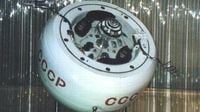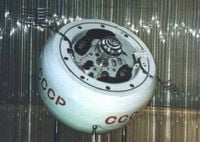The Soviet space probe Cosmos 482, which was expected to crash back to Earth over the weekend of May 10-11, 2025, has "probably" already fallen, according to Laurent Francillout, deputy director of the French National Centre for Space Studies (CNES). Francillout stated that while tracking the probe on radar, they lost sight of it on May 10, 2025. Launched in 1972, Cosmos 482 weighs around 500 kg and measures 1 meter in diameter. The probe was anticipated to pass over France and Northern Europe before its descent.
Cosmos 482 was not just any spacecraft; it was a remnant of a lesser-known space race, designed to withstand the extreme conditions of Venus, which includes temperatures exceeding 460 °C and immense atmospheric pressure. The probe was originally launched by the Soviet Union on March 31, 1972, with the intention of reaching Venus. However, it never made it to its destination due to a technical failure that prevented it from achieving the necessary velocity.
Reports indicate that the probe likely crashed into the Indian Ocean, with Roscosmos, the Russian space agency, claiming that the device entered the dense layers of the atmosphere at 9:24 AM Moscow time, approximately 560 km west of the central Andaman Islands, before falling into the ocean west of Jakarta. This information was echoed by American astrophysicist Jonathan McDowell on social media.
Marco Langbroek, a member of a project with the European Space Agency (ESA), noted that while the reports from Roscosmos align fairly well with their models, the reliability of Russian reports remains a subject of discussion. The probe, which had been in orbit for over five decades, was expected to return to Earth between May 9 and May 10, 2025. However, its trajectory was complex and difficult to predict until the last moment.
As the probe made its descent, the ESA confirmed that Cosmos 482 disintegrated upon re-entering the Earth's atmosphere, with the estimated time of disintegration around 6:04 AM UTC (8:04 AM French time) on May 10, 2025. Despite this, no direct observations of the final re-entry or impacts on the ground have been reported.
The uncertainty surrounding the exact landing location of Cosmos 482 highlights the challenges faced by astronomers and space agencies when tracking space debris. The ESA had drawn a model covering a vast area of the Earth's surface to predict where the probe might fall, given the complexities of modeling the atmosphere and the influence of space weather.
Interestingly, the return of Cosmos 482 raises questions about space debris. Currently, there are approximately 30,000 cataloged pieces of space debris larger than 10 centimeters orbiting the Earth, with over a million smaller fragments. According to Stijn Lemmens, an analyst at the ESA, the frequency of debris re-entries has increased significantly, with objects capable of creating fragments now entering the atmosphere about twice a week, compared to once every two weeks a decade ago.
While concerns about space debris are valid, experts emphasize that the risk to individuals on the ground from such objects is minimal. The Aerospace Corporation, an American company, estimates that the risk of being injured by Cosmos 482 is about 0.4 in 10,000, which is significantly lower than the risk of being struck by lightning. This statistic is reassuring, especially considering the probe's design, which was intended to survive the intense heat of Venus's atmosphere.
In addition to the immediate concerns about Cosmos 482, the broader issue of space debris management remains a critical challenge for future space missions. Jacques Arnould, a historian of science and an ethics officer at CNES, remarked that managing space waste is a pressing issue, as countries have been trying to take responsibility for the increasing amount of debris in orbit. The majority of Earth’s surface is covered by oceans, making it statistically more likely for falling debris to land in water rather than on land.
Cosmos 482’s journey, which began over fifty years ago, is a reminder of the complexities and risks associated with space exploration. Originally designed for a mission to Venus, the probe's failure to reach its target and subsequent return to Earth illustrates the unpredictable nature of space travel. The probe's disintegration and the lack of precise tracking highlight the need for continued advancements in monitoring space debris and ensuring the safety of both space missions and those of us on the ground.
As space agencies around the world continue to monitor the situation, the return of Cosmos 482 serves as a crucial reminder of the remnants of our past endeavors in space exploration and the ongoing challenges we face in managing the legacy of those missions.



